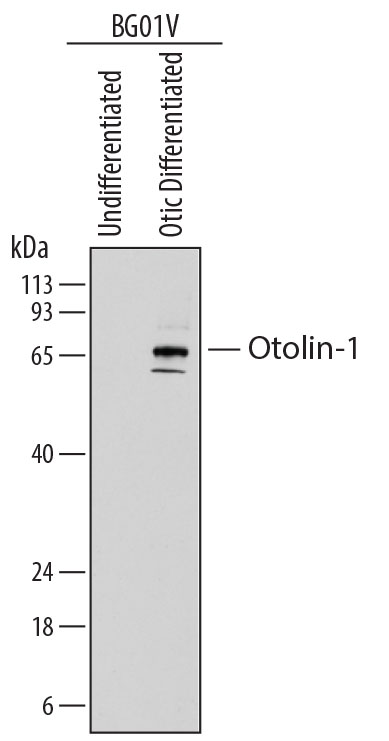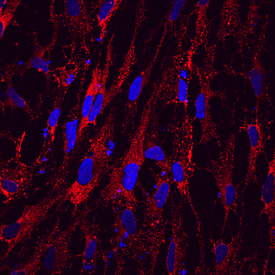Human Otolin-1 Antibody Summary
Lys24-Pro477
Accession # A6NHN0
Applications
Please Note: Optimal dilutions should be determined by each laboratory for each application. General Protocols are available in the Technical Information section on our website.
Scientific Data
 View Larger
View Larger
Detection of Human Otolin-1 by Western Blot. Western blot shows lysates of BG01V human embryonic stem cells undifferentiated or differentiated to early otic lineage. PVDF membrane was probed with 0.25 µg/mL of Mouse Anti-Human Otolin-1 Monoclonal Antibody (Catalog # MAB8045) followed by HRP-conjugated Anti-Mouse IgG Secondary Antibody (Catalog # HAF018). Specific bands were detected for Otolin-1 at approximately 60-70 kDa (as indicated). This experiment was conducted under reducing conditions and using Immunoblot Buffer Group 1.
 View Larger
View Larger
Otolin-1 in differentiated BG01V Human Embryonic Stem Cells. Otolin-1 was detected in immersion fixed BG01V human embryonic stem cells differentiated to early otic lineage using Mouse Anti-Human Otolin-1 Monoclonal Antibody (Catalog # MAB8045) at 10 µg/mL for 3 hours at room temperature. Cells were stained using the NorthernLights™ 557-conjugated Anti-Mouse IgG Secondary Antibody (red; Catalog # NL007) and counterstained with DAPI (blue). Specific staining was localized to cytoplasm. View our protocol for Fluorescent ICC Staining of Cells on Coverslips.
Reconstitution Calculator
Preparation and Storage
- 12 months from date of receipt, -20 to -70 °C as supplied.
- 1 month, 2 to 8 °C under sterile conditions after reconstitution.
- 6 months, -20 to -70 °C under sterile conditions after reconstitution.
Background: Otolin-1
Otolin (OTOL1), also known as C1qTNF15, is an approximately 65 kDa protein found in the otoconial membrane lining the cochlea and vestibular labyrinth of the inner ear. It is secreted by supporting cells of the sensory epithelium. The otoconial membrane contains particles known as otoconia which are composed of glycoproteins and proteoglycans coated with calcium carbonate crystals. Otolin is one of the protein components of otoconia particles, and it is important for otoconia formation as well as for auditory and vestibular function. It associates into multimers and disulfide-linked oligomers and also associates with other otoconial proteins including Cerebellin-1 and Otoconin-90. Otolin contains three collagen-like regions followed by a C1q-like domain at the C-terminus. It is extensively glycosylated and has multiple hydroxylated proline residues in the collagenous regions. Human Otolin shares 72% aa sequence identity with mouse and rat Otolin.
Product Datasheets
FAQs
No product specific FAQs exist for this product, however you may
View all Antibody FAQsReviews for Human Otolin-1 Antibody
There are currently no reviews for this product. Be the first to review Human Otolin-1 Antibody and earn rewards!
Have you used Human Otolin-1 Antibody?
Submit a review and receive an Amazon gift card.
$25/€18/£15/$25CAN/¥75 Yuan/¥1250 Yen for a review with an image
$10/€7/£6/$10 CAD/¥70 Yuan/¥1110 Yen for a review without an image

